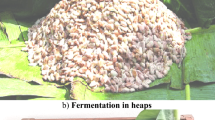Abstract
Bambara groundnut (Vigna subterranea) was fermented to produce a dawadawa-type product using a starter culture of Bacillus licheniformis isolated from naturally fermenting bambara groundnut beans. Fermentation was carried out at 30 and 37 °C for four days and at 45 °C for two days. The pH of the substrate decreased after 24 hours and then rose at 30 and 37 °C but remained constant at 45 °C after the initial drop. Total titratable acidity of the fermenting beans mimicked the pH values. Proximate analyses for moisture, protein and fat of the cotyledons showed an increase in all three constituent at each of the three fermentation temperatures. At the end of fermentation, total available carbohydrate was 55%, 59% and 62% of the original value at 30, 37 and 45 °C, respectively. Fermentation of bambara groundnut at 45 °C for two days is recommended as the ideal fermentation temperature and time.
Similar content being viewed by others
References
Poulter NH (1981) Properties of some fractions from bambara groundnut (Voandzeia subterranea (L.) Thouars). J Sci Food Agric 32: 44–50.
Kay DE (1979) Bambara groundnut. In Food Legumes. London. Tropical Products Institute. TPI Crop and Product. Digest No. 3, pp 17–25.
Odunfa SA (1981) Microorganisms associated with fermentation of African locust bean (Parkia folliciodae) during iru preparation. J Plant Food 3: 245–250.
Barber L, Achinewhu SC, Ibiama EA (1988) The microbiology of ogiri production from castor oil seed (Ricinus communis). Food Microbiol 5: 177–183.
Barber L, Achinewhu SC (1992) Microbiology of ‘ogiri’ production from melon seeds (Citrullus vulgaris). Nigerian Food J 10: 129–135.
Barimalaa IS, Achinewhu SC, Idisi Y, Amadi EN (1994) Studies on the solid substrate fermentation of bambara groundnut (Vigna subterranea (L.) Verdc). J Sci Food Agric 66: 443–446.
Odunfa SA (1986) Dawadawa. In Reddy NR, Pierson MD, Salunkhe DK (eds), Legumebased fermented foods. Boca Raton, FL: CRC Press.
Sutardi, Buckle KA (1985) Phytic acid changes in soybeans fermented by traditional inoculum and six strains of Rhizopu oligosporus. J Appl Bact 58: 539–543.
Agosin E, Daniel D, Arevena R, Yanez E (1989) Chemical and nutritional characterization of lupine tempe. J Food Sci 54: 102–107.
Heseltine CW (1965) A millennium of fungi, food and fermentation. Mycologia 57: 149–197.
Bergey's Manual of Determinative Bacteriology (1974) Ed. Buchanan RE, Gibbons NE. Baltimore: Williams and Wilkins Company.
Wellington EMH, Williams ST (1978) Preservation of actinomycete inoculum in frozen glycerol. Microbios Letts 6: 151–157.
Harrigan WF, McCance ME (1990) Laboratory Methods in Food and Dairy Microbiology. London: Academic Press.
AOAC (1984) Official Methods of Analysis, 14th ed. Washington, DC: Association of Official Analytical Chemists.
Osborne DR, Voogt P (1978) The Analysis of Nutrients in Foods. London: Academic Press, pp 130–134.
Nout MJR, Rombouts FM, Havelaar A (1989) Effect of accelerated natural lactic acid fermentation of infant food ingredients on some pathogenic microorganisms. Int J Food Microbiol 8: 351–361.
Odunfa SA (1983) Carbohydrate changes in fermenting beans (Parkia follicoidae) during iru preparation. Qual Plant Food Hum Nutri 32: 3–10.
Eka OU (1980) Effect of fermentation on the nutritional status of locust bean seed. Food Chem 5: 303–308.
Fields MK, Yoa F (1990) Nutritional improvement of cornmeal by fermentation by Bacillus licheniformis and Enterobacter cloaca. J Food Protect 53: 245–248.
Author information
Authors and Affiliations
Rights and permissions
About this article
Cite this article
Amadi, E., Barimalaa, I. & Omosigho, J. Influence of temperature on the fermentation of bambara groundnut (Vigna subterranea) to produce a dawadawa-type product. Plant Foods Hum Nutr 54, 13–20 (1999). https://doi.org/10.1023/A:1008003118374
Issue Date:
DOI: https://doi.org/10.1023/A:1008003118374




